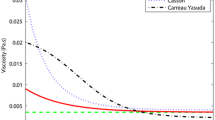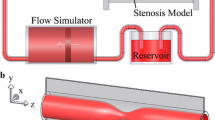Abstract
A combined magnetic resonance imaging (MRI) and computational fluid dynamics (CFD) modeling study was carried out for pulsatile flow in a carotid bifurcation phantom. The aim of the study was to quantify differences in flow patterns between MRI measurement and MRI-based CFD simulations and to further explore the potential for in vivo applications. The computational model was reconstructed from high resolution magnetic resonance (MR) scans. Velocities derived from phase-contrast MR measurements were used as boundary conditions for the CFD calculation. Detailed comparisons of velocity patterns were made between the CFD results and MRI measurements. Good agreement was achieved for the main velocity component in both well-behaved flow (in the common carotid) and disturbed region (in the carotid sinus). Comparison of in-plane velocity vectors showed less satisfactory consistency and revealed that the MR measurements obtained were inadequate to depict the secondary flow pattern as expected. It can be concluded that the combined MRI/CFD is expected to provide more reliable information about the full three-dimensional velocity field. © 2003 Biomedical Engineering Society.
PAC2003: 8761Lh, 8719Uv, 8385Pt, 8710+e
Similar content being viewed by others
References
Botnar, R., G. Rappitsh, M. B. Scheidegger, D. Liepsch, K. Perktold, and P. Boesiger. Hemodynamics in the carotid artery bifurcation: A comparison between numerical simulations and MRI measurements. J. Biomech.33:137–144, 2000.
Caro, C. G., J. M. Fitz-Gerald, and R. C. Schroter. Atheroma and arterial wall shear-dependent mass transfer mechanism for atherogenesis. Proc. R. Soc. London177:109–159, 1971.
Cebral, J. R., R. Lohaer, and J. E. Burgess, Computer simulation of cerebral artery clipping: Relevance to aneurysm neurosurgery planning. Proceedings of the European Congress on Computational Methods in Applied Science and Engineering, 2000.
Frayne, R., L. M. Gowman, D. W. Richey, D. W. Holdsworth, P. A. Picot, M. Dragova, K. C. Chu, C. B. Caldwell, A. Fenster, and B. K. Rutt. A geometrically accurate vascular phantom for comparative studies of x-ray, ultrasound, and magnetic resonance vascular imaging: Construction and geometrical verification. Med. Phys.20:415–425, 1993.
Friedman, M. H., C. B. Bargeson, O. J. Deters, G. M. Hutchins, and F. F. Mark. Correlation between wall shear and intimal thickness at a coronary artery branch. Atherosclerosis68:27–33, 1987.
Kilner, P. J., G. Z. Yang, R. H. Mohiaddin, D. N. Firmin, and D. B. Longmore. Helical and retrograde secondary flow patterns in the aortic arch studied by three-dimensional magnetic resonance velocity mapping. Circulation88:2235–2247, 1993.
Köhler, U., I. Marshall, M. B. Robertson, Q. Long, X. Y. Xu, and P. R. Hoskins. MRI measurement of wall shear stress vectors in bifurcation models and comparison with CFD predictions. J. Magn. Reson Imaging14:563–573, 2001.
Ku, D. N., D. P. Giddens, C. K. Zarins, and S. Glagov. Pulsatile flow and atherosclerosis in the human carotid bifurcation. Atherosclerosis5:293–302, 1985.
Ku, D. N., and D. P. Giddens. Laser Doppler anemometer measurements of pulsatile flow in a model carotid bifurcation. J. Biomech.20:407–421, 1987.
Long, Q., X. Y. Xu, M. W. Collins, M. Bourne, and T. M. Griffith. Magnetic resonance image processing and structured grid generation of a human abdominal bifurcation. Comput. Methods Programs Biomed.56:249–259, 1998.
Long, Q., X. Y. Xu, M. Bourne, and T. M. Griffith. Numerical study of blood flow in an anatomically realistic aorto-iliac bifurcation generated from MRI data. Magn. Reson. Med.43:565–576, 2000.
Long, Q., X. Y. Xu, U. Kohler, M. B. Robertson, I. Marshall, and P. Hoskin. Quantitative comparison of CFD predicted and MRI measured velocity fields in a carotid bifurcation phantom. Biorheology39:467–474, 2002.
Milner, J. S., J. A. Moore, B. K. Rutt, and D. A. Steinman. Hemodynamics of human carotid artery bifurcations: Computational studies with models reconstructed from magnetic resonance imaging of normal subjects. J. Vasc. Surg.27:143–156, 1998.
Moore, J. A., D. A. Steinman, and C. R. Ethier. Computational blood flow modeling: Errors associated with reconstructing finite element models from magnetic resonance images. J. Biomech.31:179–184, 1998.
Moore, J. A., D. A. Steinman, D. W. Holdsworth, and C. R. Ethier. Accuracy of computational hemodynamics in complex arterial geometries reconstructed from magnetic resonance imaging. Ann. Biomed. Eng.27:32–41, 1999.
Papathanasopoulou, P., S. Z. Zhao, U. Köhler, M. B. Robertson, Q. Long, P. Hoskins, X. Y. Xu, and I. Marshall. MRI measurement of time-resolved wall shear stress vectors in a carotid bifurcation model, and comparison with CFD predictions. J. Magn. Reson. Imaging17:153–162, 2003.
Perktold, K., M. Resch, and H. Florian. Pulsatile non-Newtonian flow characteristics in a three-dimensional human carotid bifurcation model. ASME J. Biomech. Eng.113:464–475, 1991.
Smith, R. F., B. K. Rutt, A. J. Fox, and R. N. Rankin. Geometric characterization of stenosed human carotid arteries. Acad. Radiol.3:898–911, 1996.
Steinke, W., and M. Hennerici. Three-dimensional ultrasound imaging of carotid artery plaques. J. Cardiovasc. Technol.8:15–22, 1989.
Steinman, D. A., J. B. Thomas, H. M. Ladak, J. S. Milner, B. K. Rutt, and J. D. Spence. Reconstruction of carotid bifurcation hemodynamics and wall thickness using computational fluid dynamics and MRI. Magn. Reson. Med.47:149–159, 2002.
Taylor, C. A., T. J. Hughes, and C. K. Zarines. Computational investigations of vascular disease. Comput. Phys.10:224–232, 1996.
Taylor, C. A., M. T. Draney, J. P. Ku, D. Parker, B. N. Steele, K. Wang, and C. K. Zarins. Predictive medicine: Computational techniques in therapeutic decision-making. Comput. Aided Surg.4:231–247, 1999.
Weston, S. J., N. B. Wood, G. Tabor, A. D. Gosman, and D. N. Firmin. Combined MRI and CFD analysis of fully developed steady and pulsatile laminar flow through a bend. J. Magn. Reson Imaging8:1158–1171, 1998.
Xu, X. Y., Q. Long, M. W. Collins, M. Bourne, and T. M. Griffith. Reconstruction of blood flow patterns in human arteries. Proc. Inst. Mech. Eng., Part H: J. Eng. Med.213:411–421, 1999.
Zarins, C. K., D. P. Giddens, B. K. Bharadavaj, V. S. Sottiura, R. F. Mabon, and S. Glagov. Carotid bifurcation atherosclerosis: Quantitation of plaque localization with flow velocity profiles and wall shear stress. Circ. Res.53:502–514, 1983.
Zhao, S. Z. The numerical study of fluid–solid interactions for modeling blood flow in arteries. PhD thesis, City University, London, 1999.
Zhao, S. Z., X. Y. Xu, A. D. Hughes, S. A. Thom, A. V. Stanton, B. Ariff, and Q. Long. Blood flow and vessel mechanics in a physiologically realistic model of a human carotid arterial bifurcation. J. Biomech.33:975–984, 2000.
Author information
Authors and Affiliations
Rights and permissions
About this article
Cite this article
Zhao, S.Z., Papathanasopoulou, P., Long, Q. et al. Comparative Study of Magnetic Resonance Imaging and Image-Based Computational Fluid Dynamics for Quantification of Pulsatile Flow in a Carotid Bifurcation Phantom. Annals of Biomedical Engineering 31, 962–971 (2003). https://doi.org/10.1114/1.1590664
Issue Date:
DOI: https://doi.org/10.1114/1.1590664




